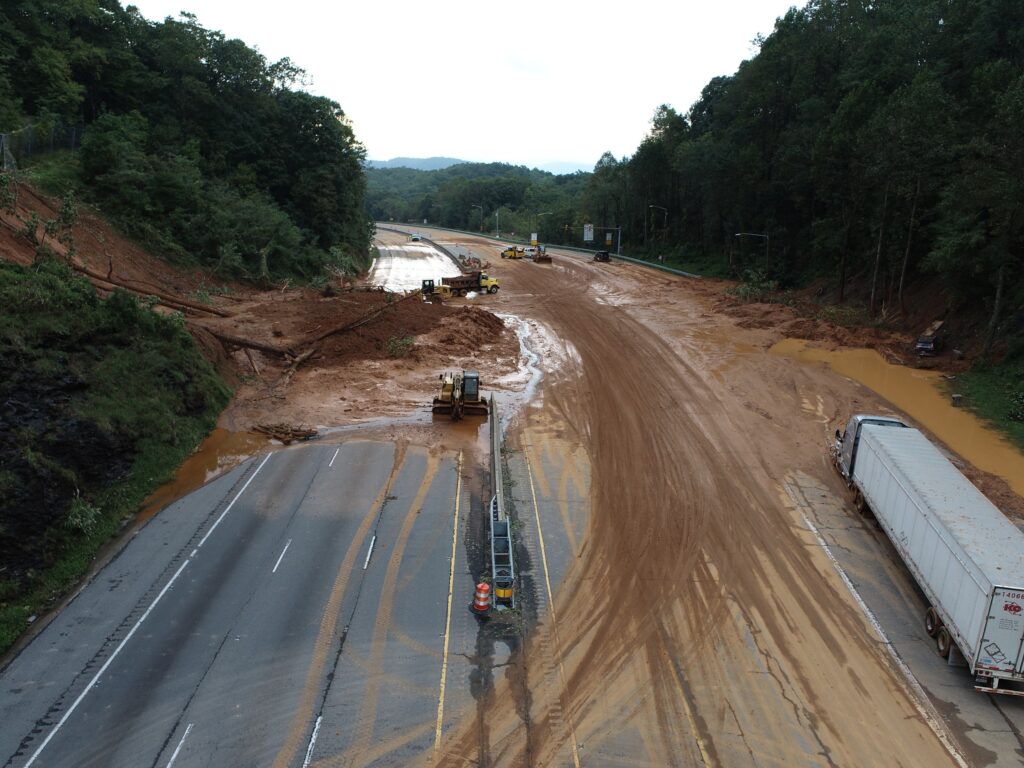Damaged roadways, mudslides and unstable ground have made it difficult to get supplies to those in Western North Carolina. The above photo is a section of I-40 near Black Mountain. (Photo: NCDOT)
Governor Roy Cooper and the state’s top emergency management officials provided an update Sunday to the ongoing, massive response to Tropical Storm Helene.
Helene dropped from 10 to 29 inches of rain across the mountains on Friday, causing life-threatening floods and landslides. The storm has claimed 11 lives in North Carolina, and officials expect that number will rise.
Gov. Cooper said the state is aware that people are desperate for help, and multiple agencies are actively pushing to get it to them.
“Many people are cut off because roads are impassable, they don’t have power or communications. Please know that we are sending resources and coordinating closely with local governments, first responders, state and federal partners, and volunteer organizations to help those impacted by this tragic storm,” said Gov. Cooper.
Because it’s difficult to trucks in the needed supplies over closed and damaged roads, the state has begun airlifting food and water into the region.
Governor Roy Cooper addresses the media about the ongoing response to Tropical Storm Helene. (Screengrab PBSNC)
A 20-bed state medical support center is opening in Caldwell County later today, and the state will be setting up more.
Nearly 464,000 customers remain without power. That’s down from a peak of more than a million customers at the height of the storm.
More than 500 North Carolina National Guard members have been deployed to work with local emergency responders conducting search and rescue missions, delivering needed supplies, and working to restore infrastructure.
President Biden granted Cooper’s request for a federal major disaster declaration providing immediate federal help for 25 North Carolina counties and the Eastern Band of Cherokee Indians.
Cell phone providers are working to fix the damage and get stopgap solutions in place.
NC Emergency Management Director Will Ray said conditions on the ground remain extremely dangerous.
“We ask people not to venture into storm-affected areas, whether to check on property, loved ones, or just to sight see. Besides endangering yourself, you could also be interfering with emergency responders or repair crews,” cautioned Ray. “Please let the professionals do their jobs.”
The state has over 730 responders conducting search and rescue efforts.
Telecommunications companies are working around the clock to restore cell phone service and mobile data to the mountains.
Ray said for those in western North Carolina, it’s recommended you turn your phones off and turn them back on periodically to allow the phone to connect to a network.
On Friday, North Carolina’s telecommunications partners activated disaster roaming on all networks. This means that any phone on any carrier can access any network to place calls.
As of midday Sunday, 280 roads remained closed in Western North Carolina because of Helene. The majority of those are in Henderson, Ash, Buncombe, Lincoln, Cleveland, Jackson, Transylvania and Yancey counties.
“Many of the closures are due to high water where the roadway is impassable or flooded. We also have several land and rockslides down power lines, pipe failures and fallen trees,” said NC Department of Transportation Secretary Joey Hopkins.
One piece of good news, according to Hopkins, a previously closed section of I-26 south of Asheville has reopened allowing responders their first major route into and out of the city.
NC Department of Transportation Secretary Joey Hopkins (Screengrab PBSNC)
Crews have also opened up a path through the slide near Old Fort on I-40 to allow some stranded vehicles and also emergency responders to pass through with assistance from the state highway patrol.
Hopkins said unnecessary travel is hindering NCDOT crews from doing the work to get the roads reopened.
“Our main message is simple, consider all roads in western North Carolina to be closed until further notice,” said the NCDOT Secretary.
One of the biggest concerns right now is the availability of clean water.
Ray said there are 93 systems that are on a boil water advisory with 33 awaiting test results to clear that advisory.
“Loss of power is one contributing factor, but we also know that there’s significant infrastructure damage from the amount of water that impacted a number of these communities, that’s going to have significant rebuild impacts for these water systems to come online,” Ray explained.
In the days ahead they will determine which water systems need simple repairs or whether an extensive overhaul of a jurisdiction’s water system is required.
“Because those are significant lifts and challenges, we are preparing our operation to continue to move commodities into those impacted areas, particularly food and water for an extended duration of time,” said Ray.
Those in need of shelter can find a list of open shelters here. As of Sunday afternoon, the one shelter is McDowell County at Glenwood Baptist Church was at full capacity.
For those who wish to donate to recovery efforts, the state will be activating North Carolina’s Disaster Relief Fund, managed by the United Way of North Carolina.

